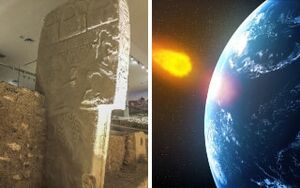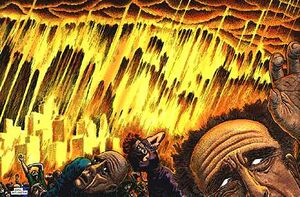UnNews:Stone carvings confirm ice age
| A newsstand that's brimming with issues | ✪ | UnNews | ✪ | Wednesday, January 7, 2026, 23:24:59 (UTC) |
| Stone carvings confirm ice age | 
|
21 April 2017
GOBEKLI TEPE, Turkey -- (![]() listen) Experts at the University of Edinburgh have analysed mysterious symbols carved into stone pillars here, which confirm that multiple comet strikes hit earth at the same time that a mini-ice age started.
listen) Experts at the University of Edinburgh have analysed mysterious symbols carved into stone pillars here, which confirm that multiple comet strikes hit earth at the same time that a mini-ice age started.
Scientists have speculated for decades that comets were behind the sudden fall in temperature during a period known as the Washa Dryas. This was disastrous for Earth, as it occurred before the invention of laundry soap suitable for cold water in either top-loaded or front-loaded machines.
Study of the Vulture Stone at Gobekli Tepe has now confirmed the theory. Anthropologists say the carvings are not simply a pair of crows carrying a horse, as they would seem to the untrained, but represent a shower of comet fragments hurtling to earth to cause global cooling.
Using a computer programme to show exactly how the constellations would have looked back then, they could pinpoint the carvings to 10,950 B.C. — the exact time the climate change began, within a millennium or so.
Humankind (which was called mankind in those days) had to react with lightning speed. Before the comet, there was wheat and barley everywhere. Afterward, these were replaced by smouldering comet pieces, which are nowhere near as savoury. Dr Martin Sweatman Ph.D., who led the Edinburgh research, said that the comet strike forced communities to come together and work out new ways of survival, such as selective breeding, in which no one puts the make on ugly chicks, no matter how desperate. This was the basis of modern civilisation, and eventually feminism.
Edinburgh researchers said the carvings remained important to the people of Gobekli Tepe for millennia, suggesting that the cold climate that followed was very serious. Either that, or there is a limit on the number of times you can re-carve a stone slab.
A sceptical school of thought holds that the interpretation of the stone carvings owes to an Edinburgh tradition in which anyone entering the pub buys a pint for everyone already inside. According to this theory, the shower of comets became evident only after a clumsy newcomer spilled lager on Dr Sweatman's spectacles.
Sources[edit]
- Sarah Knapton "Ancient stone carvings confirm how comet struck Earth in 10,950BC, sparking the rise of civilisations". London Telegraph, April 21, 2017

